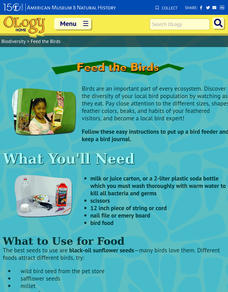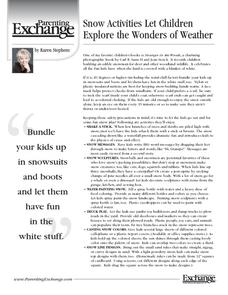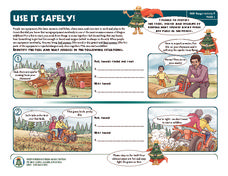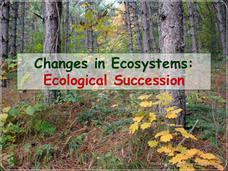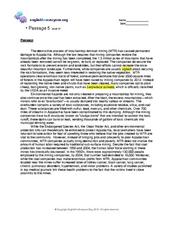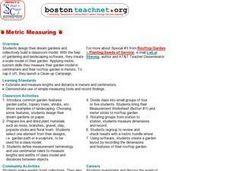Curated OER
How Does Your Garden Grow?
Young gardners read and listen to books about seeds, plants, and the growing process. They plant seeds in plastic cups to observe the process of root-growing and plant formation. The whole class walks through a field to collect seeds...
Chicago Botanic Garden
Preparing for Project BudBurst
Male deer growing antlers to begin the breeding season is an example of a phenological event. First in a four-part series is an activity requiring individuals to collect phenological data on their campus. Classes discuss phenology, the...
Chicago Botanic Garden
Preparing for Project BudBurst
Plants take cues from the environment—change in daylight hours and temperature—to complete their seasonal life cycles. Lesson four in the series of six has classes collect phenology data on plants. After taking initial observations,...
K12 Reader
Taiga Ecosystems
Introduce your class to another type of ecosystem, the taiga ecosystem, through a reading passage. Class members read the text and then respond to five reading questions about the content of the passage.
K12 Reader
Taiga Ecosystems
After reading a short article about taiga ecosystems, middle schoolers are asked to identify the characteristics of this chilly environment.
Polar Bears International
Top of the World
Learn about polar bears and the Arctic circle with a lesson about the countries and conditions of the region. After examining how the area differs from Antarctica, kids explore climates, animals, and geographical position...
American Museum of Natural History
Feed the Birds
What kinds of birds are common in the area? Young scientists use household supplies to create bird feeders. They then document the birds that come to their feeders by keeping journals.
American Museum of Natural History
Feed the Birds
Scholars use a large carton, string, an emery board, and bird food to create a hand-made bird feeder. After completing the craft, pupils keep a journal to track their observations.
Curated OER
Whose Home Is This?
After reading a short and informative paragraph on animals and their environments, learners look at pictures of four animals, and write a short description of how each one has adapted to its environment. A suggested activity is that each...
Curated OER
Desert Plant Adaptations in the Sonoran Desert
Middle schoolers are able to identify adaptations that plants have developed to deal with harsh desert conditions, as well as explain how these adaptations help to protect these plants.
Parenting Exchange
Snow Activities Let Children Explore the Wonders of Weather
Just because there's snow on the ground, it doesn't mean you can't go out and play. Take full advantage of the wonderful winter weather with this collection of fun snow day activities.
KOG Ranger Program
Use It Safely!
Campfires are not the only way that forest fires start. In a worksheet and word matching activity, young campers learn about common fuel and heat sources that, when combined, can be the spark to a dangerous and harmful forest fire.
Nuffield Foundation
Measuring Rate of Water Uptake by a Plant Shoot Using a Potometer
How quickly does a plant transpire? Learners explore this question through measuring water uptake with a potometer. They time the movement of a bubble a set distance to understand the motion and rate of speed.
Biology Junction
Changes in Ecosystems: Ecological Succession
Can an area with no soil turn into a forest? Scholars learn about the process of ecological succession using an interesting presentation. It covers both primary and secondary succession in the building of new ecosystems.
Desert Discovery
Saguaro Seasons
Elementary schoolers take a look at how the saguaro cactus adapts to the four seasons of the year. This amazing plant has distinct flowering and fruiting cycles within the summer season, and other cycles during the other seasons. Your...
Curated OER
Reading Comprehension 5: Level 10
Whether used as a reading comprehension assessment, as the basis of a mini-lesson on reading strategies, or as extra practice, this exercise will prove to be valuable because of the answers and explanation key that accompanies the...
Curated OER
Plein Air Drawing and Painting
Students plein air drawing. In this drawing skills lesson, students follow the provided steps that require them select natural objects and utilize plein air skills to complete their drawings.
Curated OER
Don't Wait, Just Propagate
Students explore the process of growing plants from seed. In this propagation activity, students examine methods of propagation and determine how to rapidly propagate plant species. Students listen to a lecture informing them on the...
Curated OER
Arizona Grown Specialty Crop Lesson Plan: Where Do They Go?
Pupils explore biotic and abiotic factors in landscape design. In this landscaping lesson, students create 3-dimensional models that represent landscape designs taking into consideration climate and planting requirements.
Curated OER
Metric Measuring
Students design their dream gardens and work together to build a class model. They use software to create a virtual model. They only use metric measurements.
Curated OER
Organisms and Their Environment
Students observe elements of a local ecosystem and gain an understanding of what elements make up an ecosystem. In this ecosystem lesson students create a class food web that shows the interactions among the elements of the...
Curated OER
Agriculture in Your Life
Students explore the origins of food and other everyday products around the United States. In this agricultural lesson, students learn basic vocabulary and practice matching common items with their agricultural source. They categorize...
Curated OER
How Healthy is the Wetland?
Students explore wetlands. In this ecology lesson, students visit a wetland site and collect data about the wetland functions. Students record their results and use the data recorded to rate the wetland site on its function.
Curated OER
What is a Dry Forest?
Learners explore the importance of the dry forest. For this science lesson, students discuss the history of dry forests and changes that have occurred due to human interaction. Learners create a map showing the historical range of the...






